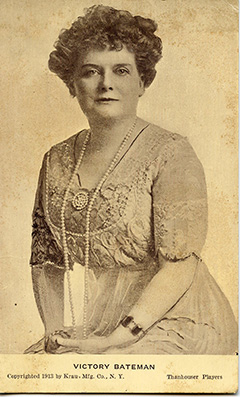 Volume III: Biographies
Volume III: Biographies Volume III: Biographies
Volume III: Biographies

Postcard courtesy Thanhouser Company Film Preservation, Inc.
Thanhouser Career Synopsis: After a career on the stage, Victory Bateman joined Thanhouser around 1912 and worked on an intermittent basis in many films for the next several years.
Biographical Notes: Victory Bateman was born in New York City on April 6, 1865 (another source says Philadelphia on April 7, 1865). Miss Bateman stated that her first name was given because she was born on the day that General Lee surrendered to Grant in the Civil War; however, that historic event took place on April 9, 1865. She was educated at St. Mary's Convent in the city of her birth. Her first stage appearance was as a child, in Rosedale, staged by the Wheatley Dramatic Association of that Philadelphia. Her first professional role was as Gertie Hacket, supporting William Terriss, in Romany Rye, in which she appeared for three seasons. Later, the actress played leading parts with Louis James and Frederick Warde.
In 1892 she appeared in The Favorite, at the Stockwell Theatre, San Francisco, supporting E.J. Henly and Aubrey Boucicault. She was in St. Louis for a season as leading woman at the Imperial Theatre, playing Carmen, Camille, Vera (in Moths), young Mrs. Winthrop, Juliet, and Portia. Her appearance as Mercy Baxter, in Caprice, was her great success of the same season. Victory Bateman played Nora Hanlon in Burmah, an English melodrama produced in Boston in 1895, and was Dearest in Little Lord Fauntleroy. She also appeared with Edwin Booth, Tomasso and Alessandro Salvini, Louis James, and others. The stock companies with which she played included those managed by H.W. Savage and A.H. Woods, for whom she appeared in Denver, St. Louis, Pittsburgh, Newark, Philadelphia, and elsewhere. Her personal life was the subject of many newspaper articles in the "yellow journalism" era of the late 1890s and early 1900s. She was named as a co-respondent in a divorce suit, her treatment for nervous exhaustion was sensationalized, and many other events were reported in a dramatic fashion. (The Robinson Locke Collection at the New York Public Library preserves many such lurid newspaper clippings.)
In the summer of 1906, Miss Bateman was the leading woman in the Bush Temple stock company in Chicago, and she may have been associated with Edwin Thanhouser around that time, for in 1907 Thanhouser leased the Bush Temple. Similarly, Thanhouser may have known her earlier when she worked with Salvini, with whom Thanhouser toured. Victory Bateman's film career is believed to have begun at Thanhouser, where she was active on an intermittent basis for three and one-half years. During part of that time she was with Majestic (which was controlled by Charles J. Hite, president of Thanhouser), appearing in Majestic films in 1912 and again beginning in the autumn of 1913. For part of 1913, until at least late summer, she appeared on the stage. She was seen in Thanhouser films intermittently through 1915.
By June 1915 the actress was with Morosco-Bosworth, for whom she was seen in Kilmeny, a film in which child actress Doris Baker also played. She later went to Victor, a division of Universal, for 11 months, then to Balboa, where she worked in late 1915. In October 1916 she appeared on the screen in the role of Lady Montague in William Fox's Romeo and Juliet. A 1916 directory noted that she was 5'4" tall, weighed 147 pounds, and had blonde hair and blue eyes. Miss Bateman died in Los Angeles on March 2, 1926, of bronchial asthma.
Thanhouser Filmography:
1912: Nicholas Nickleby (3-19-1912)
1913: A Guilty Conscience (1-5-1913), The Dove in the Eagle's Nest (1-28-1913), His Heroine (3-4-1913), For Her Boy's Sake (3-25-1913)
# # #
Copyright © 1995 Q. David Bowers. All Rights Reserved.